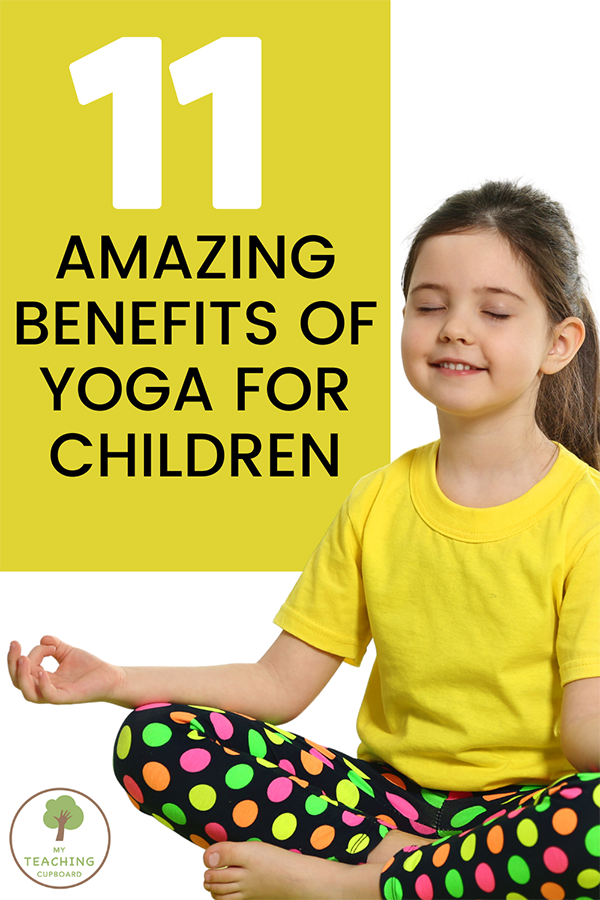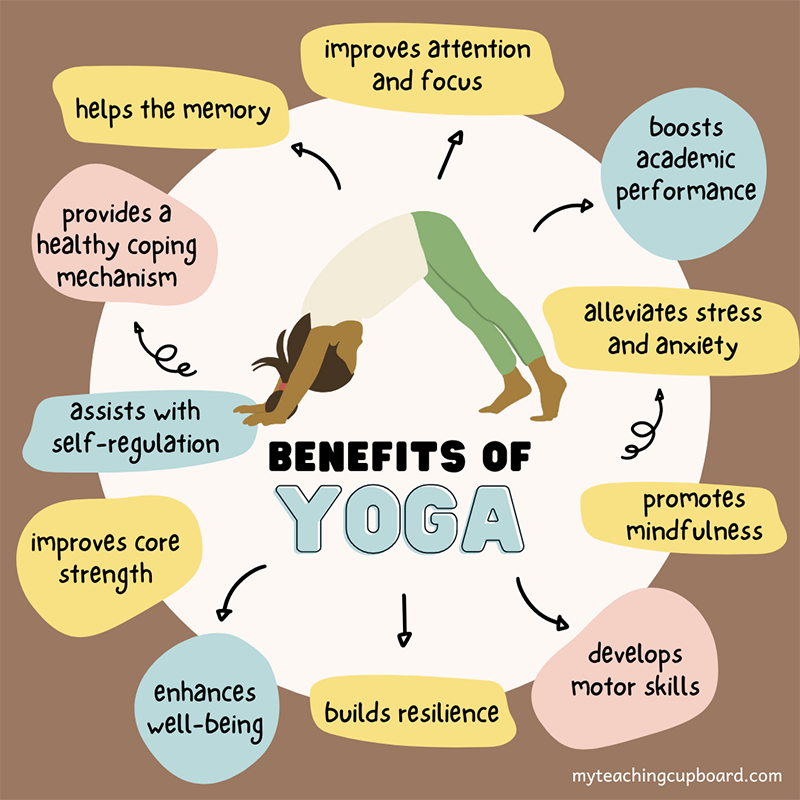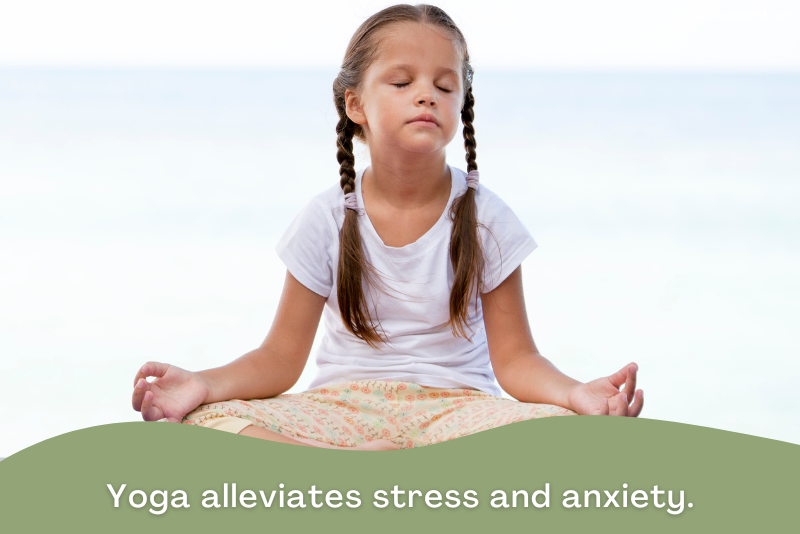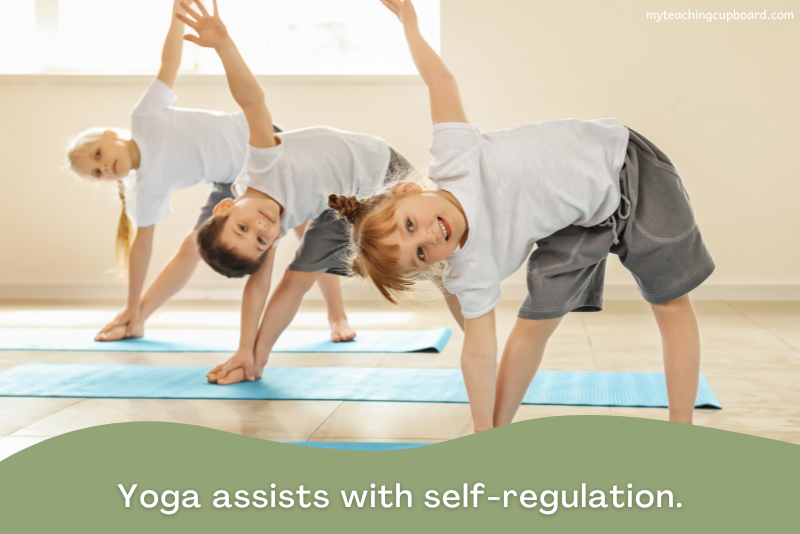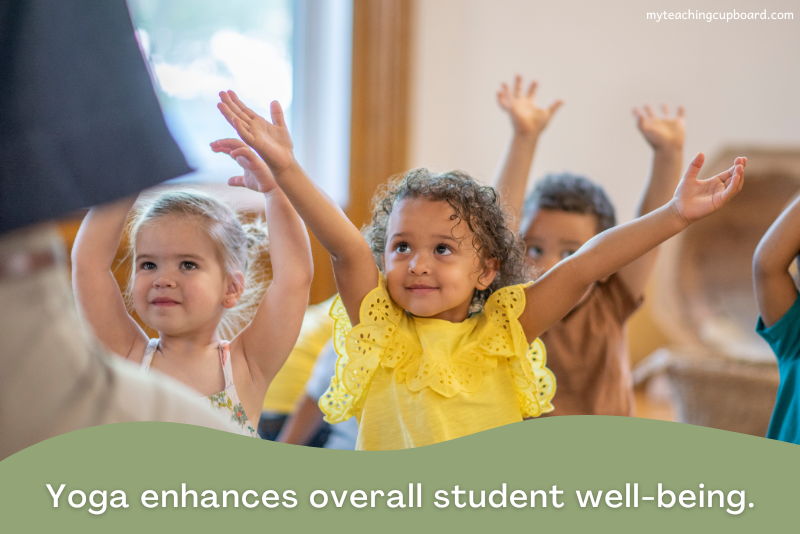11 Amazing Yoga Benefits for Children
Yoga has many benefits for children. It can help children develop their physical, emotional, and mental health, as well as promote self-awareness, concentration, and relaxation. If you are wondering if you should be practising yoga in your classroom and how classroom yoga can be of benefit to the children in your class, read on.
I have personally been doing yoga for many years. I first turned to yoga to relax and to support my mental health. Teaching can be an extremely stressful job, and I was looking for a way to relieve some of that stress. I discovered yoga was not only helping me manage my stress, but it was also helping strengthen my physical body too.
I began to look forward to my nightly yoga routine and noticed I was going to bed much more relaxed. It didn’t stop the teacher chatter that happens every night as soon as my head hits the pillow, but it definitely helped me quiet that inner voice. It helped me to relax so I could get off to sleep.
I became a yoga fan. I loved how it developed both my mental and physical strength. It wasn’t long before I realised the children in my class could benefit from some yoga practice too.
I’m always looking for ways to improve the curriculum for my students. I’m an advocate for teaching the whole child through age-appropriate and engaging learning experiences, so classroom yoga practice was something I definitely wanted to try.
Why is Yoga Good for Kids?
As you know, it’s all about best practices in the classroom. I wanted to find out all the benefits of yoga for kids, so I turned to the research on classroom yoga. I discovered there’s a lot of research on yoga and the benefits of kid’s yoga. If you are wondering what benefits yoga could have for the children in your class, here they are..
Kid’s Yoga can
improve attention and focus
help the memory
boost academic performance
alleviate stress and anxiety
build resilience
provide a healthy coping mechanism
improve core strength
develop motor skills
assist with self-regulation
promote mindfulness
enhance well-being
Yoga improves attention and focus in children.
Yoga can improve students’ attention and focus by helping them to learn how to control and balance their energy levels. If you have wriggling children, you will love yoga. Children who are hyperactive or have high energy levels may find it challenging to sit still and focus. Yoga is a tool they can use to help them calm their mind and their body.
The gentle body movements of yoga can help students release pent-up energy and tension. When you encourage your students to slowly move with intention, you will be promoting a calmer and more focused classroom environment.
Yoga poses are the perfect brain break in the classroom. Any physical activity for that matter, but especially yoga, has been shown to improve cognitive function and academic performance.
When children learn to control and balance their energy levels through yoga, it can also help them develop their self-awareness and self-regulation skills. Children will develop greater self-awareness and self-control when they learn to manage their own energy levels. This translates to better attention and focus in the classroom.
Children practising yoga become relaxed and calm. Calm, relaxed children are more likely to be engaged and motivated in the classroom. Yoga practice helps them to stay focused and on-task, and this leads to better academic performance.
You will notice your students are less moody when they practice yoga in the classroom too. Overall stress and anxiety are reduced, and this helps to create a positive classroom environment. When children feel calm and relaxed, they are more likely to be able to focus on their work and even interact more positively with their peers.
Yoga naturally promotes body awareness in children. As children focus on their body movements and their breath, they become more attuned to the sounds around them. This leads to improved auditory processing and focus. In fact, improved attention and focus are important factors in auditory processing. By practicing yoga regularly, children become better at filtering out distractions and really fine-tuning their listening skills.
Research suggests Yoga Practice improves the brain function of students and increases their ability to concentrate. It actually increases grey matter volume in areas of the brain associated with attention and memory. Yoga can even enhance the connectivity between the different brain regions and executive functioning.
These changes in brain function can help students process information more efficiently and help them to stay focused on their school tasks. Studies have found that yoga not only positively influenced children’s academic performance, but it also helped to reduce symptoms of aggressiveness, irritation, moodiness, and laziness.
Yoga is a fun and easy way to help your children become more focused and attentive in the classroom. Regularly giving your students a chance to practise yoga can create a calmer, more attentive learning environment. Yoga can help you create a positive classroom atmosphere that promotes both academic success and student well-being.
Yoga helps memory.
Yoga doesn’t only help memory. It has other benefits for the brain too. In fact, yoga can have long-lasting effects on cognitive function and overall well-being.
Did you know yoga promotes executive functioning skills in children? Executive functioning skills are the cognitive processes children use to plan, organise, and regulate their behaviour.
Yoga promotes executive functioning in children by helping them to focus on their breath and develops self-awareness and emotional regulation skills. Children’s stress and anxiety are reduced when they practice yoga because their relaxation response is triggered. The relaxation response is vital for executive functioning to occur.
Stress and anxiety can impair cognitive function and leads to attention, memory, and decision-making difficulties. The deep breathing and meditative aspects of yoga help to promote executive functioning by fostering a sense of calm and well-being.
Yoga can also promote neuroplasticity. Neuroplasticity is the brain's ability to adapt and change in response to various stimuli and experiences.
As mentioned earlier, yoga has been shown to increase grey matter volume in areas of the brain and enhance the connectivity between brain regions. Executive functioning and memory are directly influenced by the brain's grey matter and the brain's ability to connect brain regions.
Yoga promotes executive functioning and memory by improving self-regulation skills, reducing stress and anxiety, and promoting neuroplasticity. These benefits are not only seen in children but in adults too. This a good reason for you to be involved in the practicing of yoga in your classroom too!!!
Does yoga boost academic performance?
Several studies have shown that yoga can help boost academic performance in young children.
There have been numerous studies in The International Journal of Yoga and in The International Journal of Education and Psychological Research that have found school yoga programs improved academic performance, executive functioning, cognitive flexibility, working memory, attention and even reading abilities in school-aged children.
Executive functions are the cognitive processes children use to help them make good choices, stay focused, and get set tasks completed. There are three main executive functions:
Working memory: This helps students remember the things they need to do or remember instructions you have given them.
Inhibition: This helps students with their impulse control and helps them to make good choices.
Mental flexibility: This helps students to switch between tasks and adapt to changes in their routines.
Executive functions like these are important at school and can influence a student’s academic performance. The research suggests yoga can improve executive function in young children. This has the flow-on effect of boosting academic performance.
Social and emotional development plays a part in the academic performance of young children at school too. Any preschool or kindergarten teacher can tell you how these early years at school are critical for social and emotional learning. This is when children are learning to regulate their emotions and interact with others in a positive way. Yoga can help children develop these skills through relaxation, self-awareness, and empathy.
We all know how important it is to get kids up and moving at school. Movement helps children to focus, gets the blood flowing to their brain, gets the wiggles out, and just supports their overall health and well-being.
Yoga is a calming, low-impact form of exercise perfect for the classroom. It will not only help your students academically but will improve their physical strength, flexibility, and balance too.
Starting school and kindergarten can be a bit stressful for some little ones. Everything is so different, and they often need support as they adjust to a new environment and routine. Yoga can help reduce the stress and anxiety these young children feel. It can help them to relax and promote mindfulness, which in turn can lead to success and improved academic performance at school.
So, does yoga boost academic performance?
Incorporating yoga into your classroom will not only boost academic performance, but it will have a range of other benefits for the children in your class too. Yoga can improve executive function, develop social-emotional skills, provide physical activity, and help to reduce stress and anxiety. All these benefits will not only set your students up for academic success but will enhance their overall well-being too.
Yoga alleviates stress and anxiety.
It’s a common understanding that yoga helps to alleviate stress and anxiety, but how does it do that?
Yoga reduces the cortisol levels in your body. Cortisol is a hormone released by the body in response to stress. If children have high levels of cortisol, they can feel anxious and stressed. This would obviously affect their performance at school. Using yoga to reduce cortisol levels helps children feel less stressed and less anxious.
Yoga also triggers a relaxation response to help relieve stress and anxiety in children. When children practice yoga they activate the parasympathetic nervous system. This system is responsible for the relaxation response needed to help the body calm down and relax during stressful situations.
Yoga increases mindfulness too. Mindfulness is the practice of being present and aware in the current moment. It's like your mind is full of what is currently happening.
Breath awareness and mindful body scanning are two mindful practices often done in yoga. These practices can help children learn to be mindful and become more aware of their body, their thoughts, and their feelings. Mindfulness practices like these can help to alleviate anxiety and stress in children.
Yoga is a wonderful tool for children learning to self-regulate too. Through yoga, children can learn self-awareness, self-acceptance, and self-control. These skills can help them to regulate their feelings and manage any stressful situations that might happen at school.
If you are looking for an effective classroom tool to help alleviate stress and anxiety in your children, look no further than yoga. It can help by
reducing cortisol levels
promoting the relaxation response
increasing mindfulness
and developing your children’s self-regulation skills.
By incorporating yoga into your school routine, your students will be calm and relaxed!
Yoga builds resilience in children.
Resilience is the ability to adapt and cope with stress, adversity, or change. In the classroom, resilience relates to a child’s ability to quickly recover from any setbacks and to adapt when plans or classroom routines change. A resilient child can face challenges, problem solve, and overcome obstacles to their learning.
Young children need resilience and growth mindset skills to help them learn new things or to navigate school and the world around them. Our young students face so many challenges each school day. They need to separate from their caregivers, handle peer conflicts, and learn new skills (just to name a few).
Each and every school day presents young children with situations where they need to be resilient. Can you imagine how difficult this must be for them if they don’t have the skills they need? By building resilience in our little ones, we can help them to develop the skills they need. They will be able to navigate school challenges in a healthy and positive way.
Resilience is an important skill for all children to develop, and yoga can help them do it. Regular yoga practice in your classroom can help your students to build self-awareness, self-regulation, a growth mindset, and coping strategies = resilience!
We’ve already discussed how yoga helps children to develop self-awareness by helping them to become more aware of their thoughts, emotions, and physical sensations. When children use yoga to develop their self-awareness, they will learn to understand their own strengths and their own limitations. They also learn to identify and control the emotional reactions they might have to different classroom situations.
As discussed, yoga teaches children techniques for self-regulation. Through yoga, your students can master breathing exercises, and they’ll learn to be mindful. They will find it easier to manage their emotions and start to handle stress better. These are all necessary skills for self-regulation and building resilience in your students.
Yoga is also a great tool for teaching children coping strategies. Classroom yoga practice can help the children in your class to develop the coping strategies they need to navigate difficult emotions and stressful situations happening at school. By teaching relaxation techniques and self-care through yoga, your students will learn to manage their anxiety and improve their resilience.
Yoga can help foster a growth mindset in your children too. When your students have a growth mindset, they have a belief that they can learn and improve at school. Children with a growth mindset will have-a-go at difficult tasks. They persevere and don’t give up easily. By encouraging children to practice and persist with their yoga poses, they will develop a growth mindset, a sense of self-worth, and resilience skills.
Classroom yoga can be an effective tool for building resilience and coping strategies in little and big kids alike. Use yoga to build self-awareness, self-regulation, coping skills, and a growth mindset in your students. Set your students up with the skills they need to navigate challenges and setbacks in a productive and positive way.
Yoga supports creativity, individuality, and self-expression in young children too. These are all vital for building resilient children and will occur naturally when you provide opportunities for your students to practice yoga in a safe and supportive learning environment. Encourage your students to explore and express themselves with yoga if you are interested in promoting resilience in your young learners.
You can encourage these life skills by setting up a dedicated yoga area in your classroom and giving your students the space and freedom to explore different ways they can move their bodies.
Set up a Yoga Investigation Area like this in your classroom and transform your learning environment into a peaceful space where children will learn to self-regulate and calm down.
This beautiful classroom yoga pack includes everything you need to create a calming and inviting Classroom Yoga Investigation Area. A space for your students to practice yoga and mindfulness.
Included in this pack are printable posters and signs to help guide your students through their yoga practice. There are illustrated cards with basic yoga poses for your kids to try. Breathing exercises are included too.
There are even some calming visuals to decorate your yoga corner in this pack as well. You’ll find bunting, banners, and inspirational quotes to inspire and motivate your students in this comprehensive yoga pack.
THIS SET CONTAINS:
A Large Yoga flag banner
12 peaceful Yoga Provocation posters
8 easy-to-follow Illustrated cards for Yoga Poses
6 Affirmation Meditation Flags
Small banners for a Calming Corner or Calm Down Corner
Ready to create a mindful yoga area in your classroom?
With these resources, you can provide your students with the tools they need to enhance their physical and mental well-being. You will be able to celebrate their individuality and encourage your students to embrace their unique qualities and strengths.
By promoting self-awareness and self-acceptance through the practice of yoga in this lovely classroom area, you will be helping your children to develop a sense of identity and self-worth. Use this area to empower your students and provide a safe and supportive space where your students can express themselves through yoga.
This classroom yoga space would also be the perfect area to cultivate mindfulness in your students. Your students will love this calming corner of your classroom. It will give your students the chance to practice yoga and help them develop the mindfulness skills they need to regulate their emotions. They’ll learn to become more resilient in the face of stress and adversity too.
Yoga provides students with a healthy coping mechanism.
We know yoga is a powerful tool for improving children’s ability to be more thoughtful and less reactive and for developing self-control, so let’s see how yoga provides students with a healthy coping mechanism.
One of the secrets to developing self-control in children is consistent yoga practice. Through regular yoga practice in your classroom, your children will be learning to develop consistent routines and habits. This will plant the seeds for developing self-discipline and self-control.
Part of self-control is breath control. In yoga, breathwork is an important part of the practice. A variety of breathing techniques that can help children learn to control their breath and regulate their emotions are practiced in yoga. By teaching children to focus on their breath, yoga can help them develop the self-control and emotional regulation skills they need to cope in the classroom.
Mindfulness has come up a lot in this blog post because it is such an important part of any classroom yoga practice. As we've already discussed, mindfulness encourages children to develop their self-control. It also teaches them to be self-aware and how to pay close attention.
Mindfulness is the first step in self-awareness and self-control. Your children are going to develop a greater sense of self-awareness as they explore mindfulness and yoga in the classroom. Mindfulness and the relaxation techniques taught in yoga, like deep breathing, visualization, and muscle relaxation, will help your children to calm their minds and regulate their emotions.
During classroom yoga practice, you will be using the power of mindfulness to help your students control their thoughts and actions and, in turn, help them to develop good coping mechanisms in any stressful situations which might happen both at school and out in the wider community.
Problem-solving skills are another important skill we should be teaching children at school. When children know how to tackle problems and how to persevere, they will be well on their way to developing a growth mindset and constructive problem-solving skills. Classroom yoga can help them along in this journey by fostering the mental clarity and focus needed in problem-solving.
Another way to provide your students with some healthy coping mechanisms is by developing that growth mindset through positive self-talk. Yoga can help build self-esteem and confidence in children by promoting positive self-talk in activities like
affirmations
positive visualization
the re-framing of negative talk.
These should all be included in your classroom yoga practice. You'll be developing your students’ growth mindsets when you focus on positive self-talk. At the same time, you’ll be promoting self-awareness and self-acceptance in your children too.
Teaching healthy coping mechanisms to the children in your class is going to benefit them both inside and outside the classroom. If you are interested in helping your children develop the skills and strategies needed to cope in stressful situations, yoga is your friend!!
Yoga improves core strength.
Developing core strength is one of the most important physical benefits of yoga for young children.
Inner core strength is essential for children's overall physical health and well-being. The inner core muscles include the muscles in the abdomen, back, and pelvis. The strength of these muscles plays a crucial role in a child’s physical health. Core strength …
helps build a strong and flexible body.
increases balance and coordination.
improves posture.
develops body awareness.
reduces injuries and improves performance.
When children have a strong inner core, they can keep their balance and coordinate their movements easier. A strong core is needed to maintain good posture too. Children will find it easier to sit and stand up straight and for longer periods of time when they have that strong core strength. It can also help prevent back pain and other posture related problems.
Core strength is also important for athletic or active children as it can help prevent falls and other injuries. Children with a strong inner core have more control over their movements. It is an important part of a child's physical health and well-being. By giving your students the opportunity to practice yoga in the classroom you will be providing optimal inner core strengthening exercises.
Yoga develops children’s motor skills.
Another physical benefit of practising yoga in the classroom is the development of motor skills in children. Both gross and fine motor skills are developed with yoga practice. We all know about motor skills and how important they are in a child’s physical development.
Good gross motor skill development helps a child to crawl, walk, and run. Fine motor skills help a child to manipulate small objects and affect the child’s ability to control a pencil and write legibly. Yoga is important for both gross and fine motor skill development.
Did you know motor skills are also linked to cognitive development and academic success at school? Through physical movements like yoga, children are developing their spatial awareness, problem-solving skills, and creativity too. Research has shown that children who have well-developed motor skills are more likely to perform well in academic tasks such as writing, reading, and mathematics. Yoga really is a teacher’s secret weapon in the classroom.
Try to include yoga movements that promote neuromuscular development in your children. Neuromuscular development is the process by which the nervous system and the muscles work together to control movement and posture in the body. This process starts early in life and continues from infancy right through to adulthood.
The nervous system and the muscles of the body are interconnected and interdependent. The development and coordination of these muscles are essential for movement, strength, and balance.
During neuromuscular development, the child’s brain and nervous system send signals to the muscles, which then respond by contracting or relaxing to create movement. This process involves the development of neural pathways and the refinement of motor skills.
There are many factors that can affect neuromuscular and motor skill development in young children. Genetics, nutrition, exercise, and the environment are a few of these factors. Including yoga as a regular classroom exercise can help to promote healthy neuromuscular development and develop motor skills in your students.
Yoga assists with self-regulation.
We have already discussed how yoga assists with developing self-regulation skills in children. The ability of a child to manage emotions, behaviour, and the ability to focus and pay attention are all influenced by a regular yoga practice in the classroom.
Yoga promotes a mind-body connection by linking the mind and body through breath awareness and movement. This can help children become more aware of their physical body, emotions, and thoughts, and can help to teach children how to independently self-regulate.
Relaxation strategies play their part in self-regulation too. Through yoga, children learn relaxation and stress reduction techniques like deep breathing, progressive muscle relaxation, and visualization. These settling techniques can help children calm down and manage their emotions when they feel overwhelmed or anxious.
Mindfulness will help children improve their focus and attention in class too. Through yoga, you will see your children learning to pay attention to their breath, their body, and their surroundings. Being mindful and staying in the present moment leads to self-awareness and self-reflection. Vital skills for children learning to self-regulate.
Yoga is such a powerful tool for helping your students to self-regulate. It promotes
a mind-body connection
relaxation and stress reduction
improved focus and attention
self-awareness and self-reflection.
By supporting your students to develop their self-regulation skills through yoga you will be helping them develop resilience, coping skills, and overall emotional well-being.
Yoga promotes mindfulness in the classroom.
Are you tired of hearing about mindfulness in this blog post?
Mindfulness and yoga go hand-in-hand.
Paying attention to the present moment with kindness and curiosity, being aware of what's happening both around us and inside us, and not getting caught up in our thoughts or concerns about the past or the future are all the things that make mindfulness in the classroom so valuable.
When you have mindful students, you have children paying attention to what's happening right now in the classroom. What teacher doesn’t dream about that happening? That’s why mindfulness is such an important skill to teach your students.
Every teacher should be on a mission to foster mindfulness in their classroom.
Honestly!! Do yourself a favour and teach your children how to use mindfulness to help them stay focused on what they are doing in the classroom. Whether it's listening to the teacher, working at their desks, or completing an assessment piece – we all want and need mindful kids.
If you have children finding it difficult to manage their emotions and struggling to calm down, mindfulness can help. When a child is feeling upset, we can remind them to use their mindfulness and yoga strategies to notice their feelings and to take deep breaths to help them calm down.
Mindfulness also teaches children to value kindness. Being respectful to ourselves and to others happens when we are mindful. Paying attention to our thoughts and feelings without judgment helps us to treat ourselves and others with kindness and respect.
In the classroom, mindfulness will help you to create a positive and supportive learning environment where everyone feels safe, respected, and able to learn. It can also help children feel more connected to themselves and their friends, which of course, can improve overall student well-being and happiness.
Mindfulness at school really is a big deal, and it is one of my top classroom learning goals. It helps students
develop important skills needed to reduce stress
improve their ability to focus and pay attention
help them to self-regulate
teach them self-awareness
foster empathy for others
support emotional and social well-being
create a more positive and supportive classroom environment.
Yoga enhances overall student well-being.
Finally, yoga is a holistic practice that is just good for overall student well-being. It has both physical and emotional benefits. Many of these benefits have already been discussed in this blog post, but yoga has many more.
Some of the other physical benefits of yoga for children are that it improves digestion and circulation. When the children in your class practice yoga, they will be increasing their blood flow. This leads to an improvement in their stamina, better organ function, and better overall physical well-being.
Yoga is also good for the immune system. The immune system helps to keep us healthy and well. Often when children start school their immune system works in overdrive as they are in contact with so many new bugs and illnesses. Yoga activates the lymphatic system, and that can help boost children’s immune systems. Who’d have thought classroom yoga practice could lead to fewer colds, fewer sick days from school, and a stronger immune system?
We know how yoga helps children to relax by teaching them techniques that help them calm their minds and relax their bodies. This can lead to a better night’s sleep, and that means better overall health, better mood, and improved academic performance.
Yoga is also a wonderful emotional support for children as they navigate school life. It can help them to learn important life skills like patience, empathy, and compassion. Yoga can even help them develop social skills and help them to form positive relationships with their peers.
Yoga can get your students thinking about social and environmental issues too. As the children in your class practice yoga, they will be learning about the importance of taking care of themselves and their surroundings. Yoga encourages a sense of connectedness and belonging in children. This can help them to act with respect, empathy, and compassion toward themselves, others, and the environment.
By including yoga in your classroom routine, the children in your class will have the opportunity to develop lifelong skills promoting healthy living and well-being. Yoga really does have such a positive impact on the physical, mental, and emotional well-being of your students, and it supports their social, emotional, and cognitive development too.
Yoga Benefits Conclusion
Including yoga in your classroom routines is a no-brainer!!
Include yoga practice in your classroom if you want to improve your students’ physical health, mental well-being, and academic performance. Classroom yoga is going to also reduce stress, increase student focus and attention, and promote self-awareness and positive behaviour!!
I know from experience, teachers also benefit from practicing yoga, so make sure you practise with your students whenever you can. Regularly practising yoga with your students will help you manage your own stress levels and help you create a calm and supportive classroom environment. It’s a win-win!!
So why not give yoga a try in your classroom? It's a simple and effective way to enhance learning and promote overall wellness for everyone involved!
In this blog post, you discovered many yoga benefits for children and for yourself, so if you enjoyed this post and found it useful, other teachers might too. Please consider sharing it.
Just CLICK the sharing box below.👇

